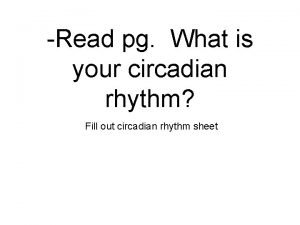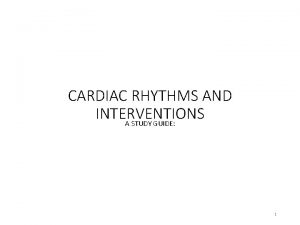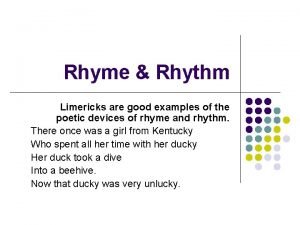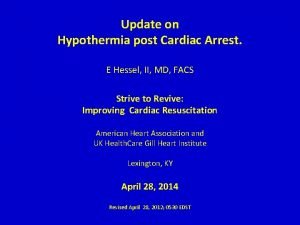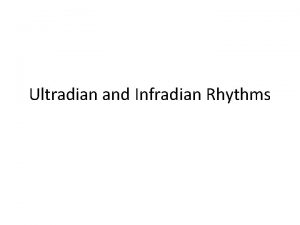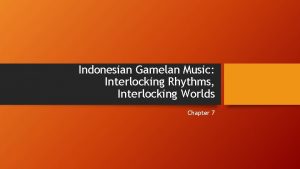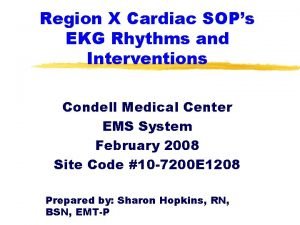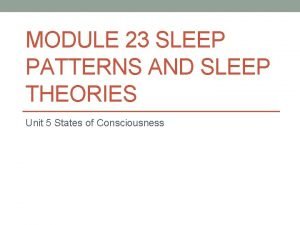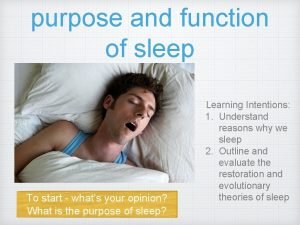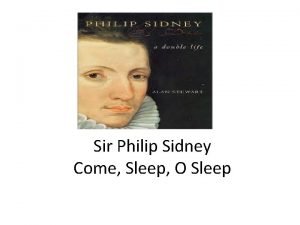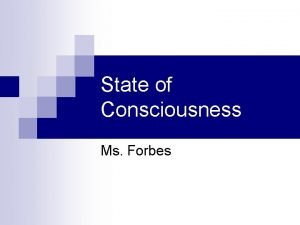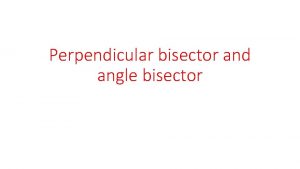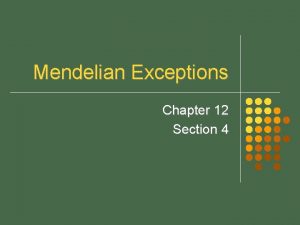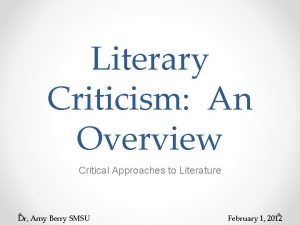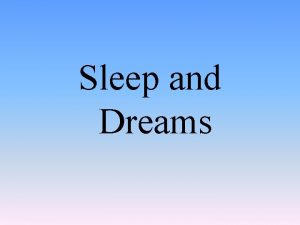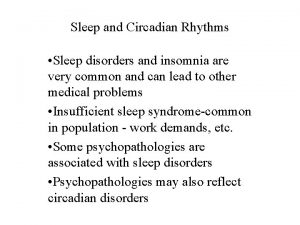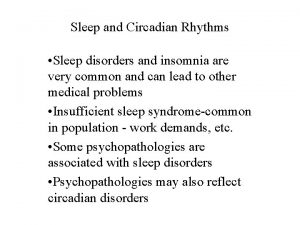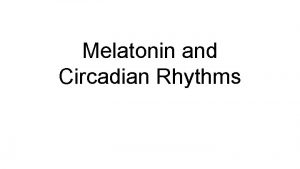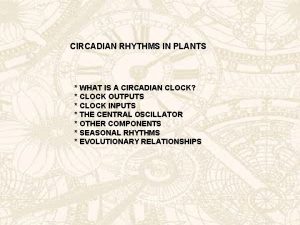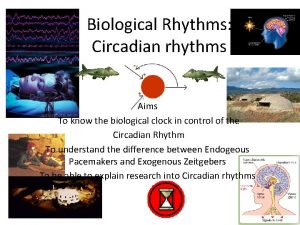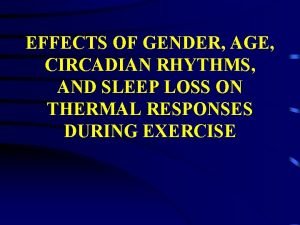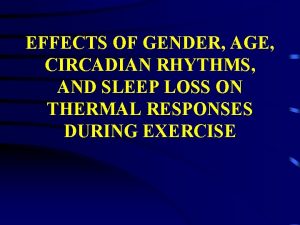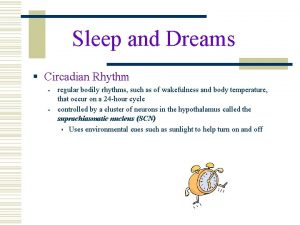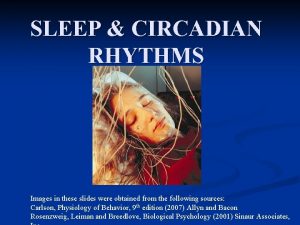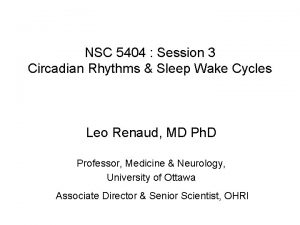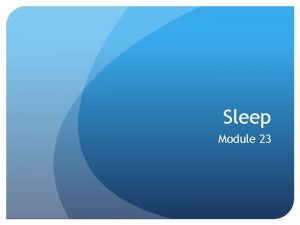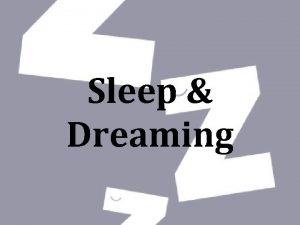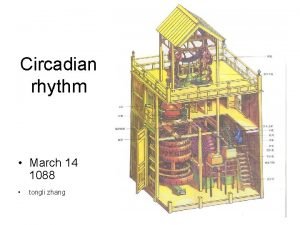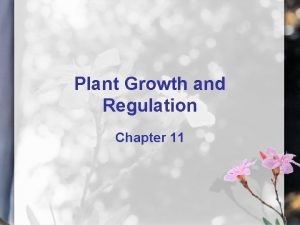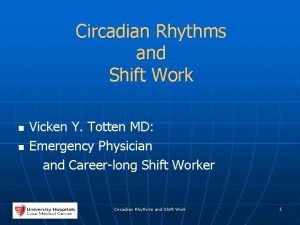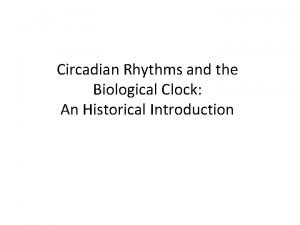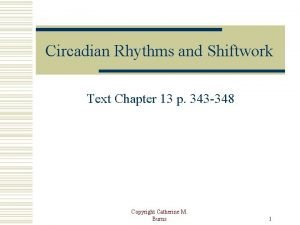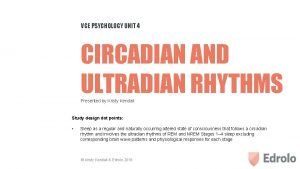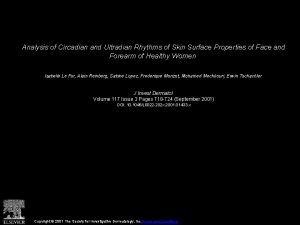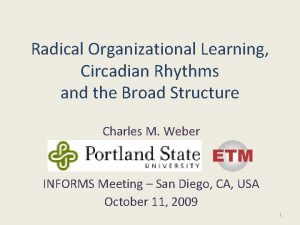Sleep Circadian Rhythms and Performance Applying Sleep Science































- Slides: 31

Sleep, Circadian Rhythms, and Performance Applying Sleep Science to Operational Practice Gregory Belenky, M. D. Hans Van Dongen, Ph. D. Sleep and Performance Research Center Washington State University Spokane

The Earth at Night: The Problem of 24/7 Operations From www. freemaninstitute. com/nightearth. htm Sleep and Performance Research Center Washington State University

Fatigue Degrades Performance • Fatigue degrades performance: – – Simple performance, e. g. , reaction time Complex performance, e. g. , accurate situational awareness Perseverance slips into perseveration Overall, slowing the Observe, Orient, Decide, Act (OODA) Loop • Fatigue is a combination of – time awake (sleep loss) – time of day (circadian rhythm) – time on task (workload) • Simple and complex performance are degraded by – extended time on task – sleep loss – adverse circadian phase • Performance is impaired by systematic degradation and increased instability Sleep and Performance Research Center

Components of Fatigue: Time Awake, Time of Day, Time on Task Sleep and Performance Research Center Adapted from Wesensten et al. , 2004

Physiology of Sleep and Performance Research Center Washington State University

The 24 -Hour Sleep/Wake Cycle 0000 Waking 0600 1800 § Two distinct states of sleep cycling with a 90100 min periodicity § Recuperation is a function of total sleep time Sleep and Performance Research Center Non-Rapid Eye Movement Sleep (NREM) Rapid Eye Movement Sleep (REM) 1200 Washington State University

Total Sleep Deprivation Imaging Studies Throughput (Percent of Baseline) 120 - Mean Performance (N=17) - Cubic Spline - Linear Regression 100 80 60 40 20 0 PET Scans 0 24 48 72 Sleep Deprivation (Hours) 86 From Thomas ML, Sing HC, Belenky G, et al. (2000). Neural basis of alertness and cognitive performance impairments during sleepiness. I. Effects of 24 h of sleep deprivation on waking human regional brain activity. Journal of Sleep Research 9: 335 -352. And from Thomas ML, Sing HC, Belenky G, et al. (2003). Neural basis of alertness and cognitive performance impairments during sleepiness. II. Effects of 48 and 72 h Sleep and on Performance Research Center. Thalamus & Related Systems 2: 199 -229. Washington State University of sleep deprivation waking human regional brain activity.

Brain Metabolism at 24, 48, & 72 Hours of Sleep Deprivation 24 h SD 48 h SD N = 17 72 h SD Z > 4. 16 + 32 mm AC-PC 3. 08 2. 58 + 8 mm AC-PC 2. 33 1. 65 Relative to baseline, the prefrontal cortex and the thalamus are most affected by sleep loss Sleep and Performance Research Center From Thomas ML, Sing HC, Belenky G, et al. (2000). Neural basis of alertness and cognitive performance impairments during sleepiness. I. Effects of 24 h of sleep deprivation on waking human regional brain activity. Journal of Sleep Research 9: 335 -352. And from Thomas ML, Sing HC, Belenky G, et al. (2003). Neural basis of alertness and cognitive performance impairments during sleepiness. II. Effects of 48 and 72 h of sleep deprivation on waking human regional brain activity. Thalamus & Related. Washington Systems 2: 199 -229. State University

Circadian Rhythm in Core Body Temperature, Sleep Propensity, and Performance Sleep and Performance Research Center Washington State University

Core body temperature (ºC) Psychomotor vigilance 10% fastest RTs (ms) Circadian Rhythm in Body Temperature and Performance Sleep and Performance Research Center From Van Dongen HPA, Dinges DF (2005). Circadian rhythms in sleepiness, alertness, and performance. In Kryger MH, Roth T, Dement WC (Eds. ), Principles and Practice of Sleep Medicine (4 th ed. ). Elsevier Saunders, Philadelphia, Pennsylvania: 435 -443.

Sleep Deprivation vs. Alcohol Intoxication Dawson & Reid, 1997 Sleep and Performance Research Center Washington State University

Chronic Partial Sleep Restriction: Effects on Performance A Sleep Dose Response Study Sleep and Performance Research Center Washington State University

Psychomotor Vigilance Task Performance across Sleep Restriction and Recovery From Belenky G, Wesensten NJ, Thorne DR, Thomas ML, Sing HC, Redmond DP, Russo MB, Balkin TJ (2003). Patterns of performance degradation and restoration during sleep restriction and subsequent recovery: a sleep dose-response study. Journal of Sleep Research 12: 1 -12. Sleep and Performance Research Center Washington State University

Recuperative Value of Sleep and Performance Research Center Washington State University

Consolidated vs. Split vs. Fragmented Sleep • • Recuperative value of sleep depends on total sleep time over 24 hours Consolidated sleep – Nocturnal (night) – typically 7 -8 hours; facilitated by circadian rhythm – Diurnal (day) – typically ~ 5 hours; truncated by circadian rhythm • Split sleep – 5 nocturnal / 2 -3 diurnal • Fragmented sleep – Awakening every 2 -3 minutes – Fragmentation to this degree abolishes recuperative value of sleep • Sleep interrupted every 20 mins as recuperative as uninterrupted sleep Sleep and Performance Research Center Bonnet M & Arand D (2003) Clinical effects of sleep fragmentation vs. sleep deprivation. Sleep Medicine Reviews, 7(4) 297 -310 Washington State University

Objective Measurement of Sleep and Performance in the Field Environment & Integration with Modeling Sleep and Performance Research Center Washington State University

Objective Field Measurement of Sleep and Performance • Palm OS Psychomotor Vigilance Test (PVT) • 10 minute test • Work/Sleep Log • Sleep periods • Start/Stop times of shift • Actigraph watches • Wear 24 hrs/day • Monitors sleep • More reliable than selfreported sleep • Equivalent to polysomnography in measuring total sleep time / 24 hours Sleep and Performance Research Center

Effect of Sleep Loss on Performance on the Psychomotor Vigilance Test (PVT) 12 Hours Awake 36 Hours Awake 60 Hours Awake 84 Hours Awake Sleep and Performance Research Center Washington State University

Actigraph Data Scored to Generate Sleep/Wake History Nighttime Awakening Daytime Nap Sleep and Performance Research Center Washington State University

Actigraph Sleep/Wake History Input to Mathematical Performance Prediction Model Nighttime Awakening Sleep and Performance Research Center Daytime Nap Washington State University

Fatigue Risk Management System (FRMS) • Five-tiered defense-in-depth to prevent fatigue-related errors, incidents, and accidents • Tier 1 – Does system of shift timing and duration allow for adequate opportunity for sleep? • • • Self-report Wrist-worn actigraph (sleep watch) Tier 3 – In the workplace, do they maintain adequate alertness and performance? • • • Predictive modeling Tier 2 – Do employees take advantage of the sleep opportunity? • • • Computer-based rostering Self-report & co-worker report Palm Pilot-based Psychomotor Vigilance Task (PVT) Embedded performance metrics Tier 4 – Are there errors, near misses? Tier 5 – Are there incidents and accidents? Sleep and Performance Research Center From Dawson D, Mc. Culloch K (2005). Managing fatigue: It’s about sleep. Sleep Medicine Reviews 9: 365 -380.

Reprise of Sleep Physiology and Performance § Fatigue is a function of sleep/wake history, circadian rhythm, and workload Ø Sleep loss degrades performance Ø Sleep restores it § All performance degrades with sleep loss Ø Slower to observe, orient, decide, and act (OODA) § Adequate total sleep time sustains performance Ø Naps add to total sleep time Ø Divided sleep is as good as consolidated sleep § Performance and sleep propensity follow the 24 hour circadian rhythm in body temperature Sleep and Performance Research Center Washington State University

The Sleep and Performance Research Center Gang Sleep and Performance Research Center Washington State University

Point of Contact Gregory Belenky, MD Research Professor and Director Sleep and Performance Research Center Washington State University P. O. Box 1495 Spokane, WA 99210 -1495 Phone: FAX: Email: Sleep and Performance Research Center (509) 358 -7738 (509) 358 -7810 belenky@wsu. edu Washington State University

The End Sleep and Performance Research Center Washington State University

Consequences of Sleep Loss § Short term Ø Minutes, hours Ø Error, accident, catastrophe § Mid-term Ø Weeks, months, years Ø Bad planning, inadequate strategizing, poor life decisions § Long-term Ø Years Ø Possibly promote cardiovascular disease, hypertension, overweight/obesity, type II diabetes, sleep disordered breathing § Triad of factors supporting health, productivity, and well-being Ø Diet Ø Exercise Ø Sleep and Performance Research Center Washington State University

Brain Metabolism during Non-REM and REM Sleep Frontal areas are deactivated during Slow Wave Sleep; decline in blood flow of ~30% (similar to sleep deprivation) From Braun AR, Balkin TJ, Wesensten NJ, Carson RE, Varga M, Baldwin P, Selbie S, Belenky G, Herscovitch P (1997). Regional cerebral blood flow throughout the sleep-wake cycle. An H 215 O PET study. Brain 120: 1173 -1197. Frontal areas remain deactivated during REM; increase in flow to waking levels or above except in prefrontal cortex Sleep and Performance Research Center Frontal areas are slowly reactivated after awakening (sleep inertia)

CDL Volunteers in the Laboratory • Sleep measured with polysomnography (electrodes, wires, recorders) • Performance measured with computer-based tests. Sleep and Performance Research Center Washington State University

Design of the Study 8 hrs in bed 1 2 3 Adaptation Phase 3, 5, 7, 9 hrs in bed 4 5 6 7 8 9 Experimental Phase 8 hrs in bed 10 11 12 13 14 15 Recovery Phase Release from study Sleep and Performance Research Center Washington State University

Mean Sleep, Baseline, Experimental Days, & Recovery Mean Sleep Experimental Days 9 hr group – 7. 9 hrs 7 hr group – 6. 3 hrs 5 hr group – 4. 7 hrs 3 hr group – 2. 9 hrs Sleep and Performance Research Center Washington State University

Performance Prediction Modeling Integrated into Rostering and Scheduling Software § Personal biomedical status monitoring Ø Sleep/wake history (by sleep watch) Ø Circadian rhythm phase (by technology TBD) Ø Predict performance in real time person by person (by biomathematical performance prediction model) Ø Validate with embedded performance metrics, e. g. , § Lane deviation (trucking) § Flight performance (commercial aviation) § Integrate performance prediction into rostering and scheduling software Ø Integrate into the objective function Ø Optimize along with other constraints Ø Potential for automated/turnkey solution for fatigue risk management Sleep and Performance Research Center Washington State University
 Circadian rhythm
Circadian rhythm Circadian rhythm def
Circadian rhythm def Jones and bartlett 2012 ekg strips
Jones and bartlett 2012 ekg strips Poem with rhythm
Poem with rhythm Shockable and nonshockable rhythms
Shockable and nonshockable rhythms Shockable and nonshockable rhythms
Shockable and nonshockable rhythms Ultradian rhythms examples
Ultradian rhythms examples Kilitan telu
Kilitan telu Pea ekg
Pea ekg Fred fingers phonics
Fred fingers phonics Module 16 sleep patterns and sleep theories
Module 16 sleep patterns and sleep theories Module 23 sleep patterns and sleep theories
Module 23 sleep patterns and sleep theories Module 23 sleep patterns and sleep theories
Module 23 sleep patterns and sleep theories What is your favourite subject in college and why
What is your favourite subject in college and why Come sleep
Come sleep Adults spend about ______% of their sleep in rem sleep.
Adults spend about ______% of their sleep in rem sleep. Chapter 33 applying paints and enamels
Chapter 33 applying paints and enamels Assets increase on which side
Assets increase on which side Designs inside a nail enhancement
Designs inside a nail enhancement Milady chapter 28
Milady chapter 28 Chapter 17 1 providing first aid
Chapter 17 1 providing first aid Mdpt formula
Mdpt formula Performance levels
Performance levels Performance appraisal process
Performance appraisal process All performance attributes designated as joint performance
All performance attributes designated as joint performance Anthropology vs sociology
Anthropology vs sociology Wwwk-6.thinkcentral
Wwwk-6.thinkcentral Hard science and soft science
Hard science and soft science Chapter 12 lesson 2 applying mendels principles
Chapter 12 lesson 2 applying mendels principles Literary criticism approaches
Literary criticism approaches Applying mendel's principles
Applying mendel's principles Applying angle relationships
Applying angle relationships
